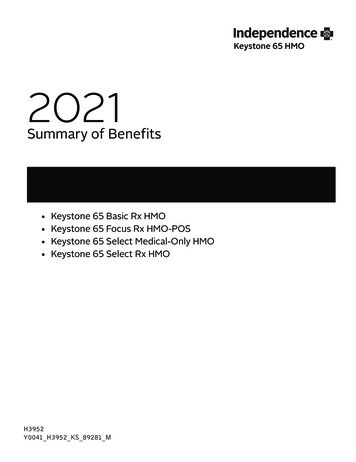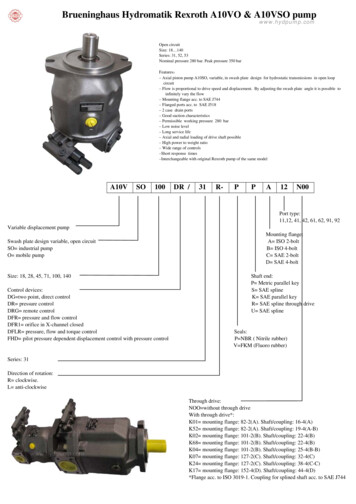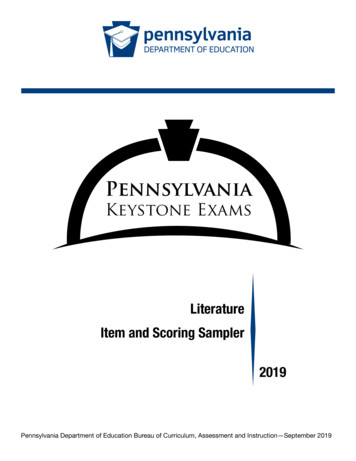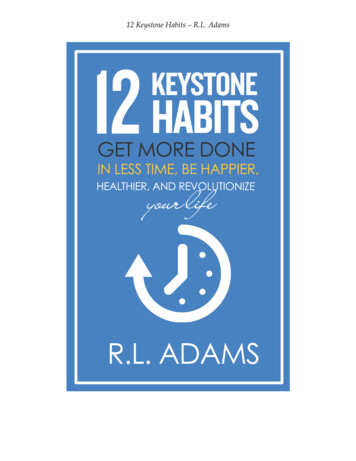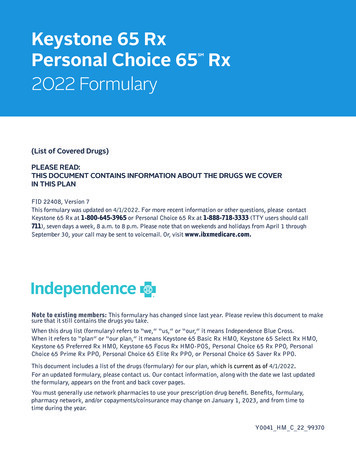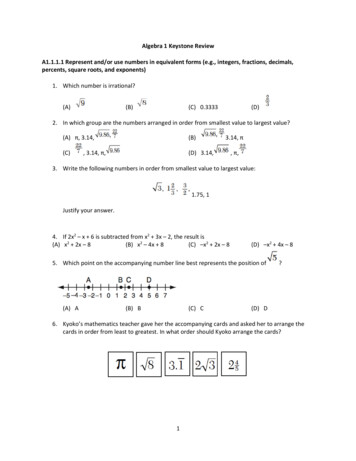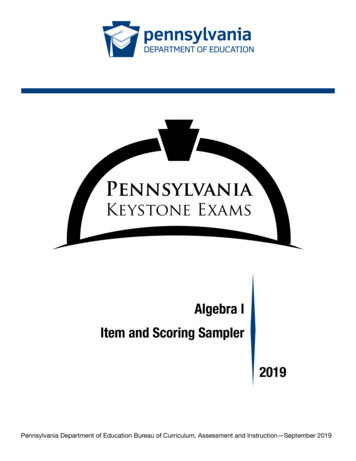
Transcription
PennsylvaniaKeystone ExamsAlgebra IItem and Scoring Sampler2019Pennsylvania Department of Education Bureau of Curriculum, Assessment and Instruction—September 2019
TABLE OF CONTENTSINFORMATION ABOUT ALGEBRA IIntroduction . . . . . . . . . . . . . . . . . . . . . . . . . . . . . . . . . . . . . . . . . . . . . . . . . . . . . . . . . . . . . . . . . 1General Introduction. . . . . . . . . . . . . . . . . . . . . . . . . . . . . . . . . . . . . . . . . . . . . . . . . . . . . . . 1About the Keystone Exams . . . . . . . . . . . . . . . . . . . . . . . . . . . . . . . . . . . . . . . . . . . . . . . . . . . . . 1Alignment . . . . . . . . . . . . . . . . . . . . . . . . . . . . . . . . . . . . . . . . . . . . . . . . . . . . . . . . . . . . . . . 1Depth of Knowledge. . . . . . . . . . . . . . . . . . . . . . . . . . . . . . . . . . . . . . . . . . . . . . . . . . . . . . . 2Exam Format. . . . . . . . . . . . . . . . . . . . . . . . . . . . . . . . . . . . . . . . . . . . . . . . . . . . . . . . . . . . . 2Item and Scoring Sampler Format. . . . . . . . . . . . . . . . . . . . . . . . . . . . . . . . . . . . . . . . . . . . . . . . 3Algebra I Exam Directions . . . . . . . . . . . . . . . . . . . . . . . . . . . . . . . . . . . . . . . . . . . . . . . . . . . . . . 4General Description of Scoring Guidelines for Algebra I. . . . . . . . . . . . . . . . . . . . . . . . . . . . . . . 6Formula Sheet . . . . . . . . . . . . . . . . . . . . . . . . . . . . . . . . . . . . . . . . . . . . . . . . . . . . . . . . . . . . . . . 7ALGEBRA I MODULE 1. . . . . . . . . . . . . . . . . . . . . . . . . . . . . . . . . . . . . . . . . . . . . . . . . . . . . . . . . . . . 8Multiple-Choice Items . . . . . . . . . . . . . . . . . . . . . . . . . . . . . . . . . . . . . . . . . . . . . . . . . . . . . . . . . 8Constructed-Response Item . . . . . . . . . . . . . . . . . . . . . . . . . . . . . . . . . . . . . . . . . . . . . . . . . . . 20Item-Specific Scoring Guideline. . . . . . . . . . . . . . . . . . . . . . . . . . . . . . . . . . . . . . . . . . . . . 22Constructed-Response Item . . . . . . . . . . . . . . . . . . . . . . . . . . . . . . . . . . . . . . . . . . . . . . . . . . . 40Item-Specific Scoring Guideline. . . . . . . . . . . . . . . . . . . . . . . . . . . . . . . . . . . . . . . . . . . . . 42Algebra I Module 1—Summary Data. . . . . . . . . . . . . . . . . . . . . . . . . . . . . . . . . . . . . . . . . . . . . 56ALGEBRA I MODULE 2. . . . . . . . . . . . . . . . . . . . . . . . . . . . . . . . . . . . . . . . . . . . . . . . . . . . . . . . . . . 58Multiple-Choice Items . . . . . . . . . . . . . . . . . . . . . . . . . . . . . . . . . . . . . . . . . . . . . . . . . . . . . . . . 58Constructed-Response Item . . . . . . . . . . . . . . . . . . . . . . . . . . . . . . . . . . . . . . . . . . . . . . . . . . . 72Item-Specific Scoring Guideline. . . . . . . . . . . . . . . . . . . . . . . . . . . . . . . . . . . . . . . . . . . . . 74Constructed-Response Item . . . . . . . . . . . . . . . . . . . . . . . . . . . . . . . . . . . . . . . . . . . . . . . . . . . 88Item-Specific Scoring Guideline. . . . . . . . . . . . . . . . . . . . . . . . . . . . . . . . . . . . . . . . . . . . . 90Algebra I Module 2—Summary Data. . . . . . . . . . . . . . . . . . . . . . . . . . . . . . . . . . . . . . . . . . . . 102Keystone Algebra I Item and Scoring Sampler—September 2019ii
INFORMATION ABOUT ALGEBRA IINTRODUCTIONGeneral IntroductionThe Pennsylvania Department of Education (PDE) provides districts and schools with tools to assist indelivering focused instructional programs aligned to the Pennsylvania Core Standards. These tools includethe standards, assessment anchor documents, Keystone Exams Test Definition, Classroom Diagnostic Tool,Standards Aligned System, and content-based item and scoring samplers. This 2018 Algebra I Item andScoring Sampler is a useful tool for Pennsylvania educators in preparing students for the Keystone Exams.This Item and Scoring Sampler contains released operational multiple-choice and constructed-responseitems that have appeared on previously administered Keystone Exams. These items will not appear onany future Keystone Exams. Released items provide an idea of the types of items that have appeared onoperational exams and that will appear on future operational Keystone Exams. Each item has been through arigorous review process to ensure alignment with the Assessment Anchors and Eligible Content statements.This sampler includes items that measure a variety of Assessment Anchor or Eligible Content statements, butit does not include sample items for all Assessment Anchor or Eligible Content statements.The items in this sampler may be used as examples for creating assessment items at the classroom leveland may also be copied and used as part of a local instructional program.1 Classroom teachers may find itbeneficial to have students respond to the constructed-response items in this sampler. Educators can thenuse the sampler as a guide to score the responses either independently or together with colleagues.This Item and Scoring Sampler is available in Braille format. For more information regarding Braillecall (717)-901-2238.ABOUT THE KEYSTONE EXAMSThe Keystone Exams are end-of-course assessments currently designed to assess proficiencies in Algebra I,Biology, and Literature. For detailed information about how the Keystone Exams are being integrated into thePennsylvania graduation requirements, please contact the Pennsylvania Department of Education or visit thePDE website at http://www.education.pa.gov.AlignmentThe Algebra I Keystone Exam consists of exam questions grouped into two modules:Module 1—Operations and Linear Equations & Inequalities, and Module 2—Linear Functions and DataOrganizations. Each module corresponds to specific content, aligned to statements and specificationsincluded in the course-specific assessment anchor documents. The Algebra I content included in theKeystone Algebra I multiple-choice items will align with the Assessment Anchors as defined by the EligibleContent statements. The process skills, directives, and action statements will also specifically align with theAssessment Anchors as defined by the Eligible Content statements.The content included in Algebra I constructed-response items aligns with content included in the EligibleContent statements. The process skills, directives, and action statements included in the performancedemands of the Algebra I constructed-response items align with specifications included in the AssessmentAnchor statements, the Anchor Descriptor statements, and/or the Eligible Content statements. In other words,the verbs or action statements used in the constructed-response items or stems can come from the EligibleContent, Anchor Descriptor, or Assessment Anchor statements.1 Thepermission to copy and/or use these materials does not extend to commercial purposes.Keystone Algebra I Item and Scoring Sampler—September 20191
INFORMATION ABOUT ALGEBRA IDepth of KnowledgeWebb’s Depth of Knowledge (DOK) was created by Dr. Norman Webb of the Wisconsin Center for EducationResearch. Webb’s definition of depth of knowledge is the cognitive expectation demanded by standards,curricular activities, and assessment tasks. Webb’s DOK includes four levels, from the lowest (basic recall)level to the highest (extended thinking) level.Level 1Level 2Depth of KnowledgeRecallBasic Application of Skill/ConceptLevel 3Level 4Strategic ThinkingExtended ThinkingEach Keystone item has been through a rigorous review process and is assigned a DOK level. For additionalinformation about depth of knowledge, please visit the PDE website at e Exams Understanding Depth of Knowledge and Cognitive Complexity.pdf.Exam FormatThe Keystone Exams are delivered in a paper-and-pencil format as well as in a computer-based onlineformat. The multiple-choice items require students to select the best answer from four possible answeroptions and record their answers in the spaces provided. The correct answer for each multiple-choice itemis worth one point. The constructed-response items require students to develop and write (or construct) theirresponses. Constructed-response items in Algebra I are scored using item-specific scoring guidelines basedon a 0–4-point scale. Each multiple-choice item is designed to take about one to one-and-a-half minutes tocomplete. Each constructed-response item is designed to take about 10 minutes to complete. The estimatedtime to respond to a test question is the same for both test formats. During an actual exam administration,students are given additional time as necessary to complete the exam.Keystone Algebra I Item and Scoring Sampler—September 20192
INFORMATION ABOUT ALGEBRA IITEM AND SCORING SAMPLER FORMATThis sampler includes the test directions, scoring guidelines, and formula sheet that appear in the KeystoneExams. Each sample multiple-choice item is followed by a table that includes the alignment, the answer key,the DOK, the percentage2 of students who chose each answer option, and a brief answer option analysis orrationale. Each constructed-response item is followed by a table that includes the alignment, the DOK, andthe mean student score. Additionally, each of the included item-specific scoring guidelines is combined withsample student responses representing each score point to form a practical, item-specific scoring guide. TheGeneral Description of Scoring Guidelines for Algebra I used to develop the item-specific scoring guidelinesshould be used if any additional item-specific scoring guidelines are created for use within local instructionalprograms.Example Multiple-Choice Item Information TableItem InformationAlignmentAssigned AAECAnswer KeyCorrect AnswerDepth of KnowledgeAssigned DOKp-value APercentage of students who selected each optionp-value BPercentage of students who selected each optionp-value CPercentage of students who selected each optionp-value DPercentage of students who selected each optionOption AnnotationsBrief answer option analysis or rationaleExample Constructed-Response Item Information TableAlignment2 AllAssigned AAECDepth ofKnowledgeAssignedDOKMean Scorep-value percentages listed in the item information tables have been rounded.Keystone Algebra I Item and Scoring Sampler—September 20193
INFORMATION ABOUT ALGEBRA IALGEBRA I EXAM DIRECTIONSDirections:Below are the exam directions available to students. These directions may be used to help students navigatethrough the exam.Formulas that you may need to solve questions in this module are found on page 7 of this testbooklet. You may refer to the formula page at any time during the exam.You may use a calculator on this module. When performing operations with π (pi), you may use eithercalculator π or the number 3.14 as an approximation of π.There are two types of questions in each module.Multiple-Choice Questions:These questions will ask you to select an answer from among four choices. First read the question and solve the problem on scratch paper. Then choose thecorrect answer. Only one of the answers provided is correct. If none of the choices matches your answer, go back and check your work forpossible errors. Record your answer in the Algebra I answer booklet.Constructed-Response Questions:These questions will require you to write your response. These questions have more than one part. Be sure to read the directions carefully. You cannot receive the highest score for a constructed-response question withoutcompleting all the tasks in the question. If the question asks you to show your work or explain your reasoning, be sure to showyour work or explain your reasoning. However, not all questions will require that youshow your work or explain your reasoning. If the question does not require that youshow your work or explain your reasoning, you may use the space provided for yourwork or reasoning, but the work or reasoning will not be scored. All responses must be written in the appropriate location within the response box in theAlgebra I answer booklet. Some answers may require graphing, plotting, labeling,drawing, or shading. If you use scratch paper to write your draft, be sure to transferyour final response to the Algebra I answer booklet.Keystone Algebra I Item and Scoring Sampler—September 20194
INFORMATION ABOUT ALGEBRA IIf you finish early, you may check your work in Module 1 [or Module 2] only.yy Do not look ahead at the questions in Module 2 of your exam materials.yy After you have checked your work, close your exam materials.You may refer to this page at any time during this portion of the exam.Keystone Algebra I Item and Scoring Sampler—September 20195
INFORMATION ABOUT ALGEBRA IGENERAL DESCRIPTION OF SCORING GUIDELINES FOR ALGEBRA I4 Points The response demonstrates a thorough understanding of the mathematical concepts andprocedures required by the task. The response provides correct answer(s) with clear and complete mathematical procedures shownand a correct explanation, as required by the task. Response may contain a minor “blemish” oromission in work or explanation that does not detract from demonstrating a thorough understanding.3 Points The response demonstrates a general understanding of the mathematical concepts and proceduresrequired by the task. The response and explanation (as required by the task) are mostly complete and correct. Theresponse may have minor errors or omissions that do not detract from demonstrating ageneral understanding.2 Points The response demonstrates a partial understanding of the mathematical concepts and proceduresrequired by the task. The response is somewhat correct with partial understanding of the required mathematical conceptsand/or procedures demonstrated and/or explained. The response may contain some work that isincomplete or unclear.1 Point The response demonstrates a minimal understanding of the mathematical concepts and proceduresrequired by the task.0 Points The response has no correct answer and insufficient evidence to demonstrate any understanding ofthe mathematical concepts and procedures required by the task.Special Categories within zero reported separately:Blank Blank, entirely erased, entirely crossed out, or consists entirely of whitespaceRefusalRefusal to respond to the taskOff TaskMakes no reference to the item but is not an intentional refusalForeign LanguageIllegibleWritten entirely in a language other than EnglishIllegible or incoherentKeystone Algebra I Item and Scoring Sampler—September 20196
INFORMATION ABOUT ALGEBRA IFORMULA SHEETALGEBRA I FORMULA SHEETFormulas that you may need to solve questions on this exam are found below.You may use calculator π or the number 3.14 as an approximation of π.Arithmetic PropertiesA lwwlAdditive Inverse:a (ˉa) 0Multiplicative Inverse:Commutative Property:1a· 1aa b b aa ·b b ·aV lwhAssociative Property:Identity Property:Linear EquationsSlope:m Point-Slope Formula:a 0 aa ·1 aDistributive Property:y2 – y1x2 – x1(y – y 1) m(x – x 1)Slope-Intercept Formula:y mx bStandard Equation of a Line:Ax By CKeystone Algebra I Item and Scoring Sampler—September 2019(a b) c a (b c)(a · b) · c a · (b · c)a · (b c) a · b a · cMultiplicative Property of Zero:a ·0 0Additive Property of Equality:If a b, then a c b cMultiplicative Property of Equality:If a b, then a · c b · c7
Algebra I1MODULE 1ALGEBRA I MODULE 1Multiple-Choice Items}1. Which expression can be simplified to the form 3 Ïy 3 , where y is a positive integer?}A. Ï18 B. Ï63 C. Ï75 D. Ï84 }}}736794Item InformationAlignmentA1.1.1.1.2Answer KeyBDepth of Knowledge2p-value A38%p-value B41% (correct answer)p-value C11%p-value D10%Option AnnotationsA student could determine the correct answer, option B, by determining thatit is the only option to meet two requirements: the number under the radicalbefore it is simplified must be a multiple of 9 in order to have a 3 outside theradical after it is simplified, and since y is a positive integer, the number underthe radical before simplifying must be at least the fourth multiple of 9, or 36.A student could arrive at an incorrect answer by finding an expression whichonly meets one of the requirements. For example, a student could arrive atoption A by meeting the requirement that the number under the radical beforeit is simplified be a multiple of 9 while not using a positive integer for y.Keystone Algebra I Item and Scoring Sampler—September 20198
1Algebra IMODULE 12. A dog’s body temperature (t), in degrees Fahrenheit ( F), is considered normal when the valueof the expression below is no more than 0.75. t – 101.75 A dog’s body temperature is 101.2 F. Based on the expression, which statement about thedog’s body temperature is true?A.Since normal body temperature is from 100.25 F to 103.25 F, the dog’s body temperatureis considered normal.B.Since normal body temperature is from 100.25 F to 103.25 F, the dog’s body temperatureis not considered normal.C.Since normal body temperature is from 101 F to 102.5 F, the dog’s body temperature isconsidered normal.D.Since normal body temperature is from 101 F to 102.5 F, the dog’s body temperature isnot considered normal.736783Item InformationAlignmentA1.1.1.3.1Answer KeyCDepth of Knowledge2p-value A15%p-value B9%p-value C61% (correct answer)p-value D15%Option AnnotationsA student could determine the correct answer, option C, by setting up theinequality t – 101.75 0.75 and solving for t to find 101 t 102.5 andcomparing the given temperature, 101.2, to this range.A student could arrive at an incorrect answer by misinterpreting the meaningof the given context. For example, a student could arrive at option D byinterpreting normal as being outside the range given by the context.Keystone Algebra I Item and Scoring Sampler—September 20199
Algebra I1MODULE 13. Over one week, a snack booth at a fair sold 362 cans of soft drinks for 1.75 each and221 hot dogs for 2.35 each. Which calculation will give the closest estimate of the salesof soft drinks and hot dogs?A.300(2) 200(2)B.400(2) 200(2)C.400(2) 200(3)D.400(2) 300(3)704018Item InformationAlignmentA1.1.1.4.1Answer KeyBDepth of Knowledge2p-value A17%p-value B69% (correct answer)p-value C10%p-value D4%Option AnnotationsA student could determine the correct answer, option B, by rounding eachquantity of items to the nearest hundred and each price to the nearest dollar.A student could arrive at an incorrect answer by rounding incorrectly. Forexample, a student could arrive at option A by rounding 362 down to 300instead of up to 400.Keystone Algebra I Item and Scoring Sampler—September 201910
Algebra I1MODULE 14. When x3 – 2x2 – 15x is factored completely, which expression is one of the factors?A.x–5B.x 5C.x2 – 5xD.x2 – 2x – 15674446Item InformationAlignmentA1.1.1.5.2Answer KeyADepth of Knowledge1p-value A36% (correct answer)p-value B12%p-value C23%p-value D29%Option AnnotationsA student could determine the correct answer, option A, by factoring an x outof each term to arrive at x(x2 – 2x – 15), and then factoring the quadratic insidethe parentheses.A student could arrive at an incorrect answer by not factoring completely. Forexample, a student could arrive at option D by stopping after the x is factoredout of each term.Keystone Algebra I Item and Scoring Sampler—September 201911
1Algebra IMODULE 15. A clothing company sells hats online to its customers. The price of each hat is p dollars. Theshipping cost is s dollars. The equation shown below can be used to find the total cost (c), indollars, when n hats are purchased.c np sWhich equation can be used to find the price of each hat when 5 hats are purchased, theshipping cost is 6, and the total cost is 41?A.c 5(6) 41B.c 6(41) 5C.41 5p 6D.41 6p 5713139Item InformationAlignmentA1.1.2.1.1Answer KeyCDepth of Knowledge2p-value A7%p-value B4%p-value C84% (correct answer)p-value D5%Option AnnotationsA student could determine the correct answer, option C, by replacing thevariables in the given equation with the corresponding numbers given in thecontext: n is replaced with 5, s is replaced with 6, and c is replaced with 41.A student could arrive at an incorrect answer by assigning given numbersto incorrect variables. For example, a student could arrive at option A byreplacing n with 5, p with 6, and s with 41.Keystone Algebra I Item and Scoring Sampler—September 201912
1Algebra IMODULE 16. An equation and some of the steps used to solve the equation are shown below. One stepis missing.2(x – 3) 10x 5(3 x)?2x – 5x 10x 15 67x 21x 3Which set of statements is most likely the missing step and the property that justifiesthe step?A.2x – (3 10x) 5(3 x)This step is justified by the associative property.B.2(x – 3) 5(3 x) – 10xThis step is justified by the associative property.C.2x – 6 10x 15 5xThis step is justified by the distributive property.D.2x – 3 10x 15 xThis step is justified by the distributive property.700870Item InformationAlignmentA1.1.2.1.2Answer KeyCDepth of Knowledge2p-value A6%p-value B7%p-value C81% (correct answer)p-value D6%Option AnnotationsA student could determine the correct answer, option C, by applying thedistributive property to arrive at an equation that is equivalent to the givenequation and leads to the equation after the question mark in one more step.A student could arrive at an incorrect answer by applying an incorrectproperty. For example, a student could arrive at answer B by applying theadditive property of equality, resulting in an equivalent equation which doesnot lead to the equation after the question mark in one step.Keystone Algebra I Item and Scoring Sampler—September 201913
Algebra I1MODULE 17. A student is selling small and large frozen pizzas for a school fund-raiser. The student earns 3 for each small pizza sold.The student earns 4 for each large pizza sold.The student has sold exactly 30 pizzas.The student has earned 100.How many small pizzas and large pizzas has the student sold?A.10 small pizzas20 large pizzasB.14 small pizzas16 large pizzasC.18 small pizzas12 large pizzasD.20 small pizzas10 large pizzas674460Item InformationAlignmentA1.1.2.2.1Answer KeyDDepth of Knowledge2p-value A6%p-value B4%p-value C3%p-value D87% (correct answer)Option AnnotationsA student could determine the correct answer, option D, by setting up asystem of equations where x is the number of small pizzas and y is the numberof large pizzas: x y 30 and 3x 4y 100, and then solving for x and y.A student could arrive at an incorrect answer by switching the associationof values. For example, a student could arrive at option A by switching themeaning of the variable assigned to the number of small pizzas with thevariable assigned to the number of large pizzas.700877Keystone Algebra I Item and Scoring Sampler—September 201914
1Algebra IMODULE 18. The system of equations below describes the relationship between the time (t), in seconds,two objects have been traveling and each object’s velocity (v), in feet per second.v ˉ 32tv ˉ 32t 16Based on the system of equations, which statement about the velocity of the objects is true?A.The objects never travel at the same velocity.B.The objects always travel at the same velocity.C.The objects travel at the same velocity only after they have been traveling for 1 second.}4D.The objects travel at the same velocity only after they have been traveling for 1 second.}2674385Item InformationAlignmentA1.1.2.2.2Answer KeyADepth of Knowledge2p-value A55% (correct answer)p-value B13%p-value C14%p-value D18%Option AnnotationsA student could determine the correct answer, option A, by setting thetwo equations equal to each other, solving to find the false statement 0 16,and interpreting this as indicating no solution.A student could arrive at an incorrect answer by finding the zero of one of theequations. For example, a student could arrive at option D by setting v 0 inthe second equation and solving for t.Keystone Algebra I Item and Scoring Sampler—September 201915
1Algebra IMODULE 19. The solution set of an inequality is shown below.012345678Which inequality has this solution set?A.1 3x 2B.1 x 2 4C.6 2x 9D.6 x 3 9713534Item InformationAlignmentA1.1.3.1.1Answer KeyDDepth of Knowledge1p-value A10%p-value B12%p-value C11%p-value D67% (correct answer)Option AnnotationsA student could determine the correct answer, option D, by identifying thesolution set as 3 x 6 and finding the inequality with the same solution set.A student could arrive at an incorrect answer by not correctly manipulatingthe inequalities. For example, a student could arrive at option B by adding 2 tocancel the 2.Keystone Algebra I Item and Scoring Sampler—September 201916
1Algebra IMODULE 110. Sandy has at least 2 times as many pencils as David has. David has 3 pencils more thanPietro has. Pietro has 4 pencils. Which number line shows the solution set for the possiblenumbers of pencils that Sandy has?A.B.C.D.01020010200102001020713762Item InformationAlignmentA1.1.3.1.2Answer KeyADepth of Knowledge2p-value A65% (correct answer)p-value B12%p-value C18%p-value D5%Option AnnotationsA student could determine the correct answer, option A, by adding 4 and 3to find the number of pencils David has and then multiplying the sum by 2 tofind the minimum number of pencils Sandy has (14) and identifying the numberline with a closed circle at 14 and shading to the right of the closed circle torepresent the situation.A student could arrive at an incorrect answer by applying operations in thewrong order. For example, a student could arrive at option C by multiplying 4by 2 and then subtracting 3 to find a minimum number of 5.Keystone Algebra I Item and Scoring Sampler—September 201917
1Algebra IMODULE 111. The graph of the solution set for a system of inequalities is shown below.y642 6 4 22 246x 4 6Which system of inequalities is represented by the graph?A.ˉ 2x y 42x 3y 6B.ˉ 2x y 42x 3y 6C.ˉ 2x y 42x 3y 6D.ˉ 2x y 42x 3y 6700863Item InformationAlignmentA1.1.3.2.1Answer KeyDDepth of Knowledge1p-value A23%p-value B18%p-value C23%p-value D36% (correct answer)Option AnnotationsA student could determine the correct answer, option D, by determining thatthe shaded region is above the line ˉ 2x y 4 and below the line 2x 3y 6.A student could arrive at an incorrect answer by switching the direction of theinequalities. For example, a student could arrive at option C by switching thedirection of both inequalities.Keystone Algebra I Item and Scoring Sampler—September 201918
1Algebra IMODULE 112. A teacher is buying word games and board games for his students. Each word game can be played by up to 4 students.Each board game can be played by 2 students.The teacher needs enough games for 30 students to play at the same time.The maximum amount that the teacher can spend on the games is 200.The number of word games (x) and the number of board games (y) the teacher buys mustsatisfy the system of linear inequalities below.4x 2y 3014.5x 18y 200The teacher plans to buy 5 word games and 8 board games. Which statement about thenumber of games the teacher plans to buy is true?A.There will be enough games for 30 students to play at the same time, but the total cost willbe greater than the maximum amount.B.There will be enough games for 30 students to play at the same time, and the total costwill be less than the maximum amount.C.There will not be enough games for 30 students to play at the same time, and the totalcost will be greater than the maximum amount.D.There will not be enough games for 30 students to play at the same time, but the total costwill be less than the maximum amount.696822724679Item InformationAlignmentA1.1.3.2.2Answer KeyADepth of Knowledge2p-value A63% (correct answer)p-value B19%p-value C12%p-value D6%Option AnnotationsA student could determine the correct answer, option A, by substituting 5 for xand 8 for y in the inequalities and then solving to find that the first inequality issatisfied but the second is not.A student could arrive at an incorrect answer by not performing all operationsafter substituting numbers for variables. For example, a student could arrive atoption B by not multiplying the number of games by the cost per game.Keystone Algebra I Item and Scoring Sampler—September 201919
1Algebra IMODULE 1CONSTRUCTED-RESPONSE ITEM13. In a science experiment, a scientist records the wavelengths of si
Keystone Algebra I Item and Scoring Sampler—September 2019 1 INFORMATION ABOUT ALGEBRA I INTRODUCTION General Introduction The Pennsylvania Department of Education (PDE) provides districts and schools with tools to assist in . owledge_and_Cognitive_Complexity .pdf . Exam Format: The Keystone .
